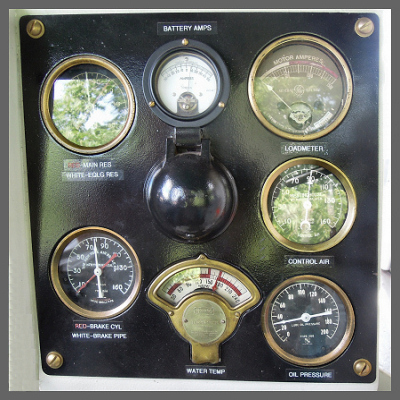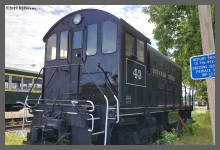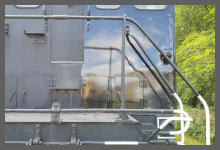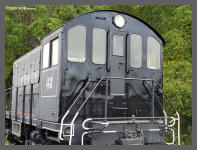BUFFALO CREEK #43
ALCO HH660
Updates 2019
by Scott H.
April - May 2019
| On May 6th, we continued the process of removing the sludge. Bob M. and Kyle D. removed and cleaned the two "CUNO" oil strainers that remove any large particles before they go though the oil filter. We also cleaned in and around the crankcase dipstick and the drain port below it. Rick B. used his carbide tipped scraper to remove all the old gasket material from the engine and the crankcase cover. He also threw our 24 volt charger on one set of batteries to get them ready for our next start up. |
| May 27th was a perfect day to refill the cooling system. First of all I have to thank "Clyde's Feed & Animal Center" for allowing us to "borrow" 285 gallons of water. Their generosity is greatly appreciated and they have always been a great neighbor. Thank you Jim! We ran about 150 feet of hose from Clyde's over to the locomotive and in under an hour, we had a full water gauge. |
June 2019

|
On June 3rd we had another productive day. #43 started without a problem and ran very smooth after it warmed up. Up until now, we have been using an auxiliary 5 gallon fuel tank to run the locomotive. At idle, the engine uses between 4 and 5 gallons per hour so keeping it full was not an issue. When the Society received the locomotive, it came with about 30 gallons in the main fuel tank. Little by little, we have drained and recycled most of the old fuel to remove any water and sediment from the tank. We were now ready to "fill her up!"
Interactive Gauge Panel Use this interactive photo of the control stand gauges to see the actual readings on the guages while the locomotive was running. "Mouse over" a gauge to see an enlarged view. |
| While our battery charger was refreshing a group of three batteries we still had some time for other chores. We had around 27 gallons of new SAE 40 weight oil left in the second oil drum. So, for future use, we filled a five gallon contanter and three clean five quart jugs with oil and took the remaining oil down to the BSOR shop. |
July 2019
| Back on June 3rd, we added 53 gallons of fresh diesel fuel to the tank of Buffalo Creek #43 which brought us up to 104 gallons. It takes about three hours of running for the generator to recharge the batteries so each time we started the locomotive we made sure we were back up to 118 volts on the batteries. So far we have logged over 15 hours on the smooth running prime mover this season. To get us to this point, we needed to fully "equalize" the charge on all the batteries which was not happening using our 24 volt commercial charger connected to three batteries at a time. On July 8th, the BSOR came to our rescue again when Pat Connors allowed us to borrow their 130volt - 20amp - 56 cell LaMarche DC charger. Rick Burns set it to "trickle" charge the entire battery bank of 14 overnight to allow every cell to equalize to the same voltage. After 24 hours, we were back up to our full charge of 118 volts. We are now looking to see if we can purchase a similar 130VDC charger to better maintain the batteries over the winter. Before our first move was made on July 15, we weed-wacked both ends of the siding to keep the wheels "dry." We were told how weeds and grass turn into "grease" when run over by the locomotive. We learned this first hand last year when we did not clear the entire siding and had some wheel slip. Appling sand eliminates this problem but we have no sanders. |
| Life member Ed Rost paid us a visit on the 22nd and showed us how to time the fuel injector pumps and adjust the governor on the engine. Ed has extensive knowledge of ALCO locomotives and his advice over the years has been greatly appreciated. In 2006, Ed met me in North Collins when the traction motors were still in the weeds, to “megger” the motors to check for shorts. (none were found) We thank you Ed for all of your expertise. Over the last few work sessions while Rick and I have been trouble shooting a small voltage leak, Bob Martin, Jim Long and Kyle Dean have been painting. Jim has one half of the interior of the engine compartment sanded and primed while Bob, Kyle and Rick prepped, primed and painted the pilot of #43. It seems like we just painted #43 but its been over seven years and unfortunately, the catalyzed urethane black paint we used has greatly faded. In the past we have done touch-up using Rust-O-Leum black enamel that has retained its gloss very well. All future painting will be finshed with Rust-O-Leum products at a much lower cost. Rick and I adjusted the timing on the throttle relay that engages the control stand relay for a smoother transition at lower RPM’s moving forward or back when the throttle is pulled. Thanks to Pat Connors for that advice. |
August 2019
| On August 5th, we added a hanger bracket for our pre-lube oil pump so it does not lean on the engine room floor. We also took voltage drop measurements on all the battery cables. Using the advice Ed Rost gave us last month, we cleaned all the fuel pump metering rods and check for smooth movement. This required us to remove a 1/2" nut and bolt in the back of each fuel pump in a 2" space, not an easy job but we got all six cleaned. On the 26th, we set the timing on all six pumps by adjusting the "throw" when it was at "top dead center" on each metering rod to make sure they all injected at the correct time on their respective power stroke. We ran the engine for over an hour and found cylinders #1 and #2 were now firing better. |
September 2019
 |
 |
Rick Burns in turn prepped the rear of the cab and was able to get one half painted on the 9th and finished the other half on the 16th. The windows were masked and covered to avoid paint spatter. |  |
October 2019
| On October 7th, after running the engine for over an hour to fully charge the batteries, Rick and Bob opened the water drain valve and emptied the cooling system. Rick barred the engine over to eliminate any air pockets. We have been flirting with low thirty degree temperatures so no sense in taking chances. Sigh, the end of a very successful season. |
| The WNYRHS greatly appreiciates all the generous donations to this project to date. However, we could still use your help! All Donations to the WNYRHS are Tax-Deductable! If you would like to mail in a donation, send it to WNYRHS Inc., PO Box 416, Buffalo, New York 14231-0416 |
| or Click the PayPal Button to make a Secure Electronic Donation. THANK YOU! |
Web Site Hosting by TRAIN WEB
The WNYRHS, Inc. P.O. Box 416, Buffalo, NY. 14231-0416 is an independent organization and has no affiliation with any other local or national group.
The Society is a fully qualified organization under 501 (C) (3) of the Internal Revenue Code and all donations to the Society are tax deductible.
©Copyright 1999 , WNYRHS Inc. all rights reserved